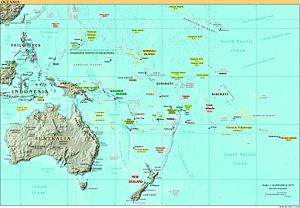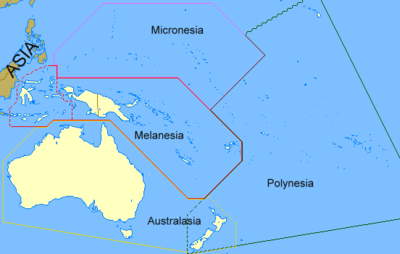Oceania
2008/9 Schools Wikipedia Selection. Related subjects: Geography of Oceania (Australasia)
Oceania
| Area | 9,008,458 km² (3,478,185.1 sq mi) |
|---|---|
| Population | 32,000,000 (6th) |
| Countries | |
| Dependencies | |
| Languages |
25 Official
|
| Time Zones | UTC+10 (Micronesia) to UTC-9 (French Polynesia) (West to East) |
Oceania (sometimes Oceanica) is a geographical, often geopolitical, region consisting of numerous lands—mostly islands in the Pacific Ocean and vicinity. The term is often used in many languages to define one of the continents and is one of eight terrestrial ecozones.
Ethnologically, the islands that are included in Oceania are divided into the subregions of Melanesia, Micronesia, and Polynesia.
The exact scope of Oceania is variably defined: it generally includes New Zealand, is often taken to include parts of Australasia such as Australia and New Guinea, and sometimes all or part of the Malay Archipelago.
Extent
Originally coined by the French explorer Dumont d'Urville in 1831, Oceania has been traditionally divided into Micronesia, Melanesia and Polynesia. As with any region, however, interpretations vary; increasingly, geographers and scientists divide Oceania into Near Oceania and Remote Oceania.
Most of Oceania consists of island nations composed of thousands of coral atolls and volcanic islands, with small human populations.
Australia is the only continental country but Indonesia has land borders with Papua New Guinea, East Timor, and Malaysia. If the Australia-New Guinea continent is included then the highest point is Puncak Jaya in Papua at 4,884 m (16,024 ft) and the lowest point is Lake Eyre, Australia at 16 m (52 ft) below sea level.
Regions
The regions and constituents of Oceania may vary according to source. In the table below, the subregions and countries of Oceania are broadly categorised according to the scheme for geographic subregions used by the United Nations, and data included are per sources in cross-referenced articles. Where they differ, provisos are clearly indicated. Apropos, according to different definitions, the following territories and regions may be subject to various other categorisations.
| Name of region, followed by countries and their flags |
Area (km²) |
Population ( 1 July 2002 estimate) |
Population density (per km²) |
Capital |
|---|---|---|---|---|
| Australasia | ||||
| 7,686,850 | 21,050,000 | 2.5 | Canberra | |
| 135 | 1,493 | 3.5 | Flying Fish Cove | |
| 14 | 632 | 45.1 | West Island | |
| 268,680 | 4,108,037 | 14.5 | Wellington | |
| 35 | 1,866 | 53.3 | Kingston | |
| Melanesia | ||||
| 18,270 | 856,346 | 46.9 | Suva | |
| 499,852 | 4,211,532 | 8.4 | Jakarta | |
| 19,060 | 207,858 | 10.9 | Nouméa | |
| 462,840 | 5,172,033 | 11.2 | Port Moresby | |
| 28,450 | 494,786 | 17.4 | Honiara | |
| 12,200 | 196,178 | 16.1 | Port Vila | |
| Micronesia | ||||
| 702 | 135,869 | 193.5 | Palikir | |
| 549 | 160,796 | 292.9 | Hagåtña | |
| 811 | 96,335 | 118.8 | South Tarawa | |
| 181 | 73,630 | 406.8 | Majuro | |
| 21 | 12,329 | 587.1 | Yaren | |
| 477 | 77,311 | 162.1 | Saipan | |
| 458 | 19,409 | 42.4 | Melekeok | |
| Polynesia | ||||
| 199 | 68,688 | 345.2 | Pago Pago, Fagatogo | |
| 240 | 20,811 | 86.7 | Avarua | |
| 4,167 | 257,847 | 61.9 | Papeete | |
| 260 | 2,134 | 8.2 | Alofi | |
| 5 | 47 | 10 | Adamstown | |
| 2,944 | 178,631 | 60.7 | Apia | |
| 10 | 1,431 | 143.1 | — | |
| 748 | 106,137 | 141.9 | Nukuʻalofa | |
| 26 | 11,146 | 428.7 | Funafuti | |
| 274 | 15,585 | 56.9 | Mata-Utu | |
| Total | 9,008,458 | 35,834,670 | 4.0 | |
| Total minus mainland Australia | 1,321,608 | 14,784,670 | 11.2 | |
See Also: List of Oceanian countries by population
Interpretative details and controversies
- New Zealand is the western corner of the Polynesian triangle. Its indigenous Māori constitute one of the major cultures of Polynesia. It is also, however, considered part of Australasia.
- Hawaii is the northern corner of the Polynesian triangle and is generally included in Oceania, though politically it is part of the United States. The Hawaiian language is a Polynesian member of the Oceanic language family, and Hawaiian culture is one of the major cultures of Polynesia.
- The U.S. territories in the North Pacific are generally considered part of Oceania.
- Rapa Nui, or Easter Island, is the eastern corner of the Polynesian triangle. A Polynesian island in the eastern Pacific Ocean and part of the territory of Chile, it is generally included in Oceania, in which case the most easterly place in Polynesia and Oceania is its dependency Sala y Gómez 415 km to the East.
- The line in Indonesia dividing Oceania from Asia varies in location and is sometimes considered to be the Wallace Line. See the transcontinental country article.
- East Timor is often reckoned as a part of Oceania due to its location to the east of the Wallace Line and its cultural ties to Pacific peoples. See transcontinental country; Biogeographically, East Timor lies within Wallacea, an ecological transition zone between Asia and Australasia. This transition is less known and less favoured these days as a continental boundary.
- Australia is sometimes not included in Oceania. Terms such as Pacific Islands or South Sea Islands might be used to describe Oceania without Australia (and New Zealand). The term "Australasia" invariably includes Australia, and usually includes New Zealand, Papua New Guinea, and some other parts of Oceania, but this term is sometimes controversial outside of Australia, as it may be seen as indicating a link with Asia — a separate continent — or as too greatly emphasising Australia. "Austral" means "of, relating to, or coming from the south", and is the common root of both Australia and Australasia.
- Although Christmas Island and the Cocos (Keeling) Islands belong to the Commonwealth of Australia, they are west of Sumatra and are commonly associated with Asia, and not with Oceania.
- In its widest sense, the term may embrace the entire insular region between Asia and the Americas, thereby including other Pacific island groups such as the Ryukyu, Kuril and Aleutian islands, and the Japanese Archipelago.
Ecogeography
Oceania is one of eight terrestrial ecozones, which constitute the major ecological regions of the planet. The Oceania ecozone includes all of Micronesia, Fiji, and all of Polynesia except New Zealand. New Zealand, along with New Guinea and nearby islands, Australia, the Solomon Islands, Vanuatu, and New Caledonia, constitute the separate Australasia ecozone.
History
Sport
Pacific Games
The Pacific Games (formerly known as the South Pacific Games) is a multi-sport event, much like the Olympics, (albeit on a much smaller scale), with participation exclusively from countries around the Pacific. It is held every four years and began in 1963.
Rugby codes
Rugby League and Rugby Union are two of the region's most popular sports. Rugby union is the national sport of New Zealand, Samoa, Fiji and Tonga and is the sixth most popular sport in Australia. Rugby League is the national sport in Papua New Guinea (the second most populous country in Oceania after Australia), is fifth most popular in Australia, and has a significant following in New Zealand.
Australia has won the Rugby Union World Cup twice, New Zealand have won the inaugural World Cup in 1987. Australia and New Zealand jointly hosted the World Cup in 1987; Australia hosted it in 2003 and New Zealand is to host it in 2011.
Australian rules football
Australian rules football is the national sport in Nauru and is third most popular in Australia. It is also very popular in Papua New Guinea.
Cricket
Cricket is the most popular and national sport of Australia, and also has a significant following in New Zealand.
Football (soccer)
Currently Vanuatu is the only country in Oceania to call football its national sport. In Australia it is the fourth most popular sport.
The Oceania Football Confederation (OFC) is one of six football (soccer) confederations under the auspices of FIFA, the international governing body of the sport. The OFC is the only confederation without an automatic qualification to the World Cup Finals. Currently the winner of the OFC qualification tournament must play-off against an Asian confederation side to qualify for the World Cup.
Oceania has only been represented at three World Cup Finals — Australia in 1974 plus 2006 and New Zealand in 1982. However, Australia is now no longer a member of the Oceania Football Confederation, having joined the Asian Football Confederation in 2006.



